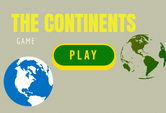Continents With Names Game Quiz Online
This Continents With Names Game Quiz Online is for students in 5th, 6th, 7th, 8th grades. Continents are large land masses. There are 7 continents in the world. as follows: Asia, Africa, North America, South America, Europe and Australia. These different land masses are unique due to the way they were formed and the where they are located. Their locations also greatly influence their constituent flora and fauna base. However, it is worth noting that continents cut across different latitudes and longitudes and hence across different climatic regions. Have fun learning about the seven continents by playing this interactive game for classrooms and individuals.

The Continents and Earth Movement
Throughout history, people have lived on the continents of the earth. What are their origins? Why do they move? What is their population? How do they move? These are questions we will answer in this article. If you want to know more about continents, read on.
Definition of Continent
Historically, the term continent was used to describe small areas of land that were not separated by seas. Although the term is still widely used today, geographers once questioned the need for continents. In his Cosmography, Peter Heylin defined a continent as a large land area. By his definition, a continent included the continents of Asia, Africa, and Europe. Another geographer, Ephraim Chambers, wrote in his Cyclopaedia that the world was divided into two large continents, Africa and Asia. Continents cover more than half of the earth's surface. While some geographers consider the two continents as one, others consider them separate continents. The former United States is divided into two parts, the North and the South, while many parts of Europe are considered a single continent. Both European nations and Latin American countries still consider their land to be one continent. In North America and Antarctica, the continents are separate.
Origin
While there are many theories as to how continents and ocean basins formed, two of the most fundamental features of our planet are the continents and oceans. As of today, the oceans cover 70.8 percent of the earth's surface, while the continents make up the remaining 29.2 percent of the planet's surface.
Two prominent theories about the origin of the continents posit that the earth is a sphere surrounded by water. One theory states that the first supercontinent was Rodinia, which was not the first. Another theory claims that the second supercontinent was Pannotia, which lasted for 60 million years before fragmenting into Gondwana and Proto-Laurasia. Then the last of these three spheres was referred to as Laurentia, which subsequently split into Siberia and the Baltic.
Population
The world is divided into seven continents: Asia, Australia, Africa, Europe, North America, and South America are the largest. Asia contains nearly 60 percent of the population of the world and comprises one-third of the world's land area. The Americas are made up of two major continents - North and South America. However, some countries, such as Central America, the Caribbean, and Greenland, are included in North America.
The most populous continent is Asia, followed by South America and Africa. The population of Africa is expected to double to a billion people in 43 years. The world's fertility rate is expected to fall to two children per woman by 2050. Most recent statistics do not include the Middle East, which is often not included in Asia. As a result, the population of the two continents may reach 7.8 billion and 10.8 billion, respectively.
Movement
Continents move much slower than ocean floors and cannot jump more than twenty centimeters per year. However, this does not mean that continents can move suddenly. In fact, continents have never turned 180 degrees in the course of ten million years, and scientists are still not sure whether or not continents will move in 50 million years.
Earlier, Wegener proposed a theory called continental drift to explain how the continents move across the Earth's surface. In his model, the continents in Pangaea broke apart and then slowly moved north until they were where they are today. Tectonic plates are huge slabs of rock that are part of the lithosphere, the surface of which is covered by the ocean. Heat from the Earth's mantle softens the rock at the bottom of these plates, causing them to shift and move due to convective forces.
Shield areas
Precambrian shield areas cover most continents. These include the Canadian, African, and Australian shields and vast areas of granitic gneisses. They overlap with sedimentary belts such as the Pacific Rim and the European Alps. In the Precambrian, the continents of North America and Europe experienced the Caledonian orogeny, which produced tectonic-metamorphic events along the east coast of North America. The Hercynian and Variscan orogenies, which affected Europe and the Ural Mountains, are also included in the Shield Areas.
Location
If you study geography, you will often hear the term "location of the continents." Whether you are a geography connoisseur or a beginner, you will learn that continents are vast tracts of land separated by oceans. These continents can be distinguished by their shape, size, and location on the globe. The equator runs horizontally on the Earth's surface. In contrast, the longitude lines run from top to bottom. From Europe to Africa, the middle line of longitude runs through the continents of England and Africa.
The continents do not always correspond to geographic regions. There are seven major land masses on Earth called continents. In the past, they were divided into continents according to geographical conventions, and today geologists consider as many as seven regions to be independent continents. There are also other regions that do not fall under a single continent, such as Zealandia, which has been called a continent.
